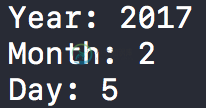iOS 获取公历、农历日期的年月日的实例代码
介绍三种方法获取 Date (NSDate) 的年月日。
用 date 表示当前日期。测试日期为公历 2017 年 2 月 5 日,农历丁酉年,鸡年,正月初九。
let date: Date = Date() NSDate *date = [NSDate date];
获取公历年月日
用 Calendar (NSCalendar) 获取公历年月日
let calendar: Calendar = Calendar(identifier: .gregorian)
print("Year:", calendar.component(.year, from: date))
print("Month:", calendar.component(.month, from: date))
print("Day:", calendar.component(.day, from: date))
NSCalendar *calendar = [NSCalendar calendarWithIdentifier:NSCalendarIdentifierGregorian]; NSLog(@"Year: %ld", [calendar component:NSCalendarUnitYear fromDate:date]); NSLog(@"Month: %ld", [calendar component:NSCalendarUnitMonth fromDate:date]); NSLog(@"Day: %ld", [calendar component:NSCalendarUnitDay fromDate:date]);
结果

用 Calendar 和 DateComponents (NSCalendar 和 NSDateComponents) 获取公历年月日
let componentSet: Set<Calendar.Component> = Set(arrayLiteral: .year, .month, .day)
let components: DateComponents = calendar.dateComponents(componentSet, from: date)
print("Year:", components.year!)
print("Month:", components.month!)
print("Day:", components.day!)
NSCalendarUnit calenderUnit = NSCalendarUnitYear | NSCalendarUnitMonth | NSCalendarUnitDay; NSDateComponents *components = [calendar components:calenderUnit fromDate:date]; NSLog(@"Year: %ld", components.year); NSLog(@"Month: %ld", components.month); NSLog(@"Day: %ld", components.day);
结果

用 DateFormatter (NSDateFormatter) 获取公历年月日
let formatter: DateFormatter = DateFormatter()
print("Date formatter identifier:", formatter.calendar.identifier) // gregorian by default
formatter.dateFormat = "y"
print("Year:", formatter.string(from: date))
formatter.dateFormat = "M"
print("Month:", formatter.string(from: date))
formatter.dateFormat = "d"
print("Day:", formatter.string(from: date))
NSDateFormatter *formatter = [[NSDateFormatter alloc] init]; NSLog(@"Date formatter calendar: %@", formatter.calendar.calendarIdentifier); // gregorian by default formatter.dateFormat = @"y"; NSLog(@"Year: %@", [formatter stringFromDate:date]); formatter.dateFormat = @"M"; NSLog(@"Month: %@", [formatter stringFromDate:date]); formatter.dateFormat = @"d"; NSLog(@"Day: %@", [formatter stringFromDate:date]);

获取农历年月日
用 Calendar (NSCalendar) 获取农历年月日
与公历相似,更改 Calendar (NSCalendar) 的初始化即可,其他代码相同
let calendar: Calendar = Calendar(identifier: .chinese)
NSCalendar *calendar = [NSCalendar calendarWithIdentifier:NSCalendarIdentifierChinese];
结果

用 Calendar 和 DateComponents (NSCalendar 和 NSDateComponents) 获取农历年月日
同上节用 Calendar (NSCalendar) 获取农历年月日
用 DateFormatter (NSDateFormatter) 获取农历年月日
与公历相似,在初始化 DateFormatter (NSDateFormatter) 之后,给 calendar 属性赋值即可,其他代码相同
let formatter: DateFormatter = DateFormatter() formatter.calendar = Calendar(identifier: .chinese)
NSDateFormatter *formatter = [[NSDateFormatter alloc] init]; formatter.calendar = [NSCalendar calendarWithIdentifier:NSCalendarIdentifierChinese];
结果

计算日期年份的生肖
自定义一个类 ChineseCalendar 来计算。十二生肖数组写在类外面。
private let Zodiacs: [String] = ["鼠", "牛", "虎", "兔", "龙", "蛇", "马", "羊", "猴", "鸡", "狗", "猪"]
十二生肖数组
ChineseCalendar 的类方法
static func zodiac(withYear year: Int) -> String {
let zodiacIndex: Int = (year - 1) % Zodiacs.count
return Zodiacs[zodiacIndex]
}
static func zodiac(withDate date: Date) -> String {
let calendar: Calendar = Calendar(identifier: .chinese)
return zodiac(withYear: calendar.component(.year, from: date))
}
测试
print("Chinese zodiac string:", ChineseCalendar.zodiac(withDate: date))
结果

计算日期年份的天干地支
在 ChineseCalendar 中用类方法计算。天干地支数组写在类外面。
天干地支数组
private let HeavenlyStems: [String] = ["甲", "乙", "丙", "丁", "戊", "己", "庚", "辛", "壬", "癸"] private let EarthlyBranches: [String] = ["子", "丑", "寅", "卯", "辰", "巳", "午", "未", "申", "酉", "戌", "亥"]
ChineseCalendar 的类方法
static func era(withYear year: Int) -> String {
let heavenlyStemIndex: Int = (year - 1) % HeavenlyStems.count
let heavenlyStem: String = HeavenlyStems[heavenlyStemIndex]
let earthlyBrancheIndex: Int = (year - 1) % EarthlyBranches.count
let earthlyBranche: String = EarthlyBranches[earthlyBrancheIndex]
return heavenlyStem + earthlyBranche
}
static func era(withDate date: Date) -> String {
let calendar: Calendar = Calendar(identifier: .chinese)
return era(withYear: calendar.component(.year, from: date))
}
测试
print("Chinese era string:", ChineseCalendar.era(withDate: date))
结果

以上就是本文的全部内容,希望对大家的学习有所帮助,也希望大家多多支持小牛知识库。
-
本文向大家介绍Javascript获取当前日期的农历日期代码,包括了Javascript获取当前日期的农历日期代码的使用技巧和注意事项,需要的朋友参考一下 JavaScript代码 调用 效果: 九月十一就是当天的农历日期
-
本文向大家介绍获取阴历(农历)和当前日期的js代码,包括了获取阴历(农历)和当前日期的js代码的使用技巧和注意事项,需要的朋友参考一下 本文为大家分享了一段js显示阴历(农历)和当前日期的关键性代码,供大家参考,具体内容如下 页面调用代码: 代码二:用JavaScript获取当前农历日期 知道如何获取农历,如何呢获取当前日期也很简单。 页面调用代码: 希望本文所述对大家利用js代码获取阴历(农历)
-
本文向大家介绍批处理万年历实现代码(包括农历日期),包括了批处理万年历实现代码(包括农历日期)的使用技巧和注意事项,需要的朋友参考一下 核心源码 以下是各计算部分算法: 计算星期: 基姆拉尔森计算公式 W= (d+2*m+3*(m+1)/5+y+y/4-y/100+y/400) mod 7 在公式中d表示日期中的日数+1,m表示月份数,y表示年数。 注意:在公式中有个与其他公式不同的地方: 把一月
-
介绍 农历日期,提供了生肖、天干地支、传统节日等方法。 使用 构建ChineseDate对象 ChineseDate表示了农历的对象,构建此对象既可以使用公历的日期,也可以使用农历的日期。 //通过农历构建 ChineseDate chineseDate = new ChineseDate(1992,12,14); //通过公历构建 ChineseDate chineseDate = new C
-
日历demo,可以显示阳历和阴历,显示范围是1900年到2100年。左右滑动手势切换月份,标题点击出现年份和月份选择器,“今天”按钮返回当日,每天日期均可点击(接口已经预留),“今天”的lable背景呈现黄色。 [Code4App.com]
-
在calendarview中,起初我可以设置日期,但当我单击将日历更改为上个月或下个月的两个按钮时,我无法获得哪个月和哪一年。更重要的是,Calendarview支持滑动到前一个月或下个月,但我无法获得现在显示日历的年月信息。我怎么能看到(现在显示)日历的年月信息?? 在此处输入图像描述 在此处输入图像描述

